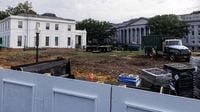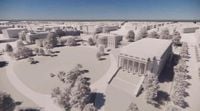On October 1, 2025, as the federal government entered a shutdown, a curious image began making the rounds on social media: a screenshot that appeared to show People magazine running a story about the White House’s latest construction project, but with a twist. Instead of the usual portrait of President Donald Trump, the image depicted him dressed as Marie Antoinette, powdered wig and all—a satirical jab at the president’s penchant for opulence. The screenshot, which was quickly picked up by users on X (formerly Twitter), was shared by the official press office account of California Governor Gavin Newsom. The post, captioned to spell out the word “CLOWN” (“Crooked Lunatic Obsessed With Nonsense”), was an unmistakable dig at Trump and his administration.
But as Lead Stories reported, the viral screenshot was a fabrication. While the real People magazine article did cover the White House’s new ballroom construction, it featured a standard portrait of Trump in a blue suit and red tie—not the elaborate costume concocted by social media pranksters. The manipulated image had stripped away the article’s subheadline and byline, pasting the satirical Trump over the real article’s headline and logo. For those who took a closer look, the truth was easy to spot, but in the fast-moving world of online commentary, many simply ran with the joke.
According to People magazine, the genuine article was titled “White House Will Continue Construction on 90,000-Square-Foot Ballroom During Government Shutdown.” The $200 million project, the magazine clarified, is being funded entirely through private donations, rendering it immune to the effects of the shutdown that began that same day. The article’s actual photo depicted Trump as he usually appears—no powdered wigs, no period costumes, just the president overseeing another chapter of White House history.
This episode was just the latest in an ongoing digital tit-for-tat between Governor Newsom and President Trump. As People magazine noted in a separate piece published on October 1, Newsom had recently taken to trolling Trump with his own AI-generated roast videos. The California governor’s press office adopted Trump’s all-caps style, mimicking the president’s social media persona in a bid to turn the tables on the administration’s use of mockery and digital spectacle. The article, titled “Gavin Newsom Fires Back at Trump’s String of Deepfake Videos with His Own AI Roast of JD Vance and a Couch,” detailed how Newsom’s team had embraced satire and digital tools to respond to Trump’s online antics.
Meanwhile, the real story at the White House was unfolding not on social media, but on the South Lawn, where construction crews officially broke ground on the new ballroom on October 3, 2025. The 90,000-square-foot addition, which will extend into the East Wing, is designed to accommodate up to 900 guests for state dinners and official events. According to TNND, this is just one of several major modifications President Trump has made to the executive mansion since returning to office.
Other changes have included the addition of golden trim to the Oval Office doorways and a gilded presidential seal on the ceiling above the Resolute Desk. Trump also personally paid for two large flag poles, now flying massive American flags on both the North and South Lawns. The Rose Garden received its own makeover: the grass was replaced with stone paving, a move Trump justified by noting that high heels kept sinking into the lawn during events. The redesign also introduced yellow-and-white striped umbrellas and tables reminiscent of the Mar-a-Lago resort, further stamping Trump’s personal style onto the historic residence.
The cost of these renovations has been a subject of public curiosity and, in some quarters, controversy. The White House has been quick to emphasize that taxpayers are not footing the bill for the latest round of changes. Trump has personally covered the expenses for the gold decorations and flag poles, while the ballroom’s estimated $200 million price tag is being paid through private donations. NPR reported that the $1.9 million Rose Garden renovation was funded by private contributions to the Trust for the National Mall.
These projects have continued unabated despite the government shutdown, a point that has not gone unnoticed by critics and commentators alike. The shutdown, which began on October 1, 2025, has left many federal workers furloughed and vital services in limbo. Yet, because the ballroom project is privately funded, construction has been able to proceed without interruption. This juxtaposition—grand renovations at the executive mansion amid a broader climate of budgetary uncertainty—has fueled debate over presidential priorities and the symbolism of such lavish undertakings.
Of course, Trump’s modifications are not without precedent. As the White House Historical Association points out, every president and first lady has left their mark on the residence, often facing criticism at the time for changes that later became accepted or even celebrated. In 1902, Theodore Roosevelt modernized the White House and created the West Wing. Harry Truman’s 1952 renovation gutted and rebuilt the mansion’s interior for safety reasons. Over the centuries, the building has evolved from a simple neoclassical structure into a living museum of American history, shaped by the tastes and priorities of its occupants.
According to the White House Historical Association, even seemingly minor changes have sparked controversy in their day. Jacqueline Kennedy’s restoration of the White House interiors, for example, was initially met with skepticism but is now widely regarded as a high point of mid-century design. In this context, Trump’s ballroom and gilded flourishes are just the latest chapter in a long tradition of presidential personalization—a tradition that often reflects not just the character of the officeholder, but also the political and cultural climate of the times.
Yet, the current moment is undeniably fraught. The intersection of real renovations and viral misinformation has created a climate where fact and parody blur, especially in the digital age. The fake People magazine screenshot, while humorous to some, underscores the ease with which misinformation can spread and shape public perceptions. The fact that it was shared by a state governor’s official account adds another layer of complexity to the ongoing rivalry between California and the Trump administration.
As construction crews continue their work on the White House ballroom, the debate over presidential legacy, public spending, and the power of digital media shows no sign of abating. Whether Trump’s additions will one day be seen as iconic or controversial remains to be seen. For now, they stand as a testament to the enduring—and sometimes contentious—tradition of making history at 1600 Pennsylvania Avenue.



